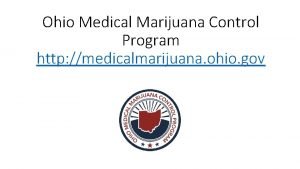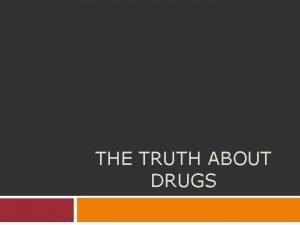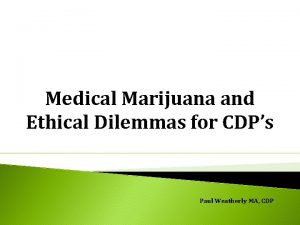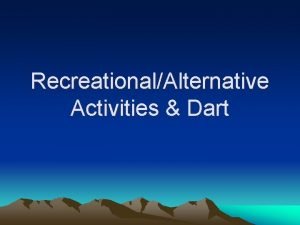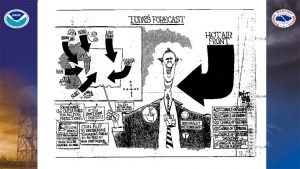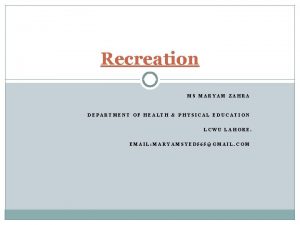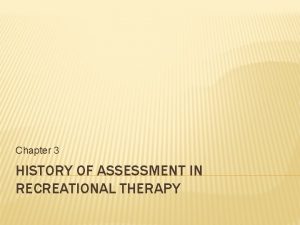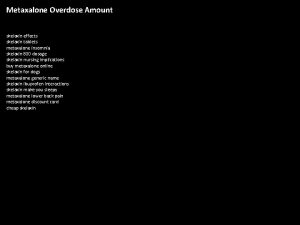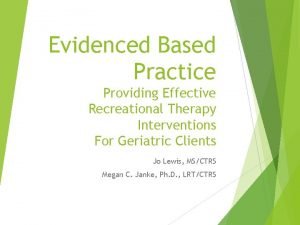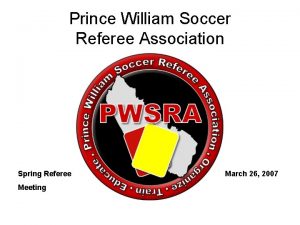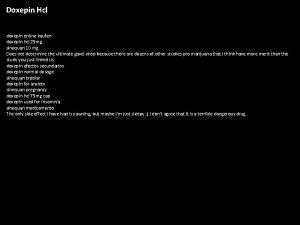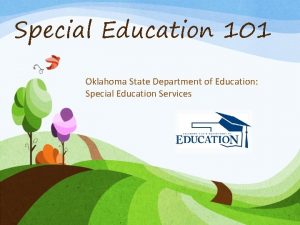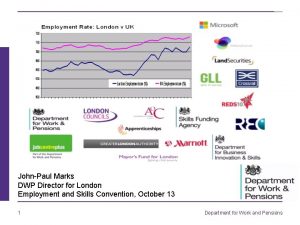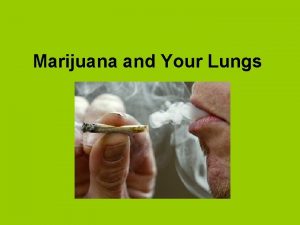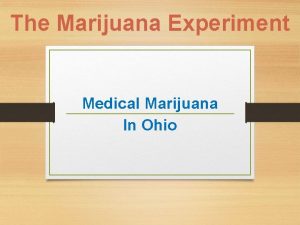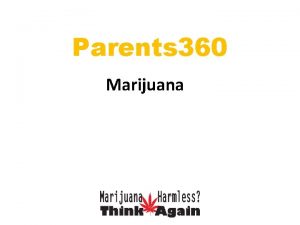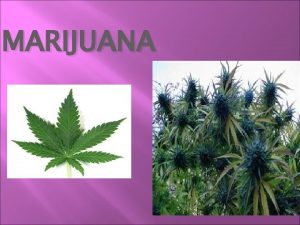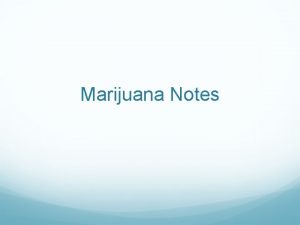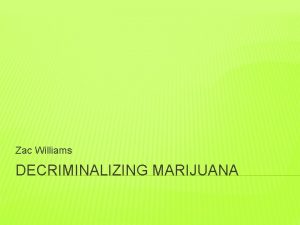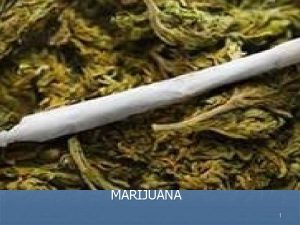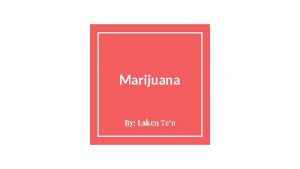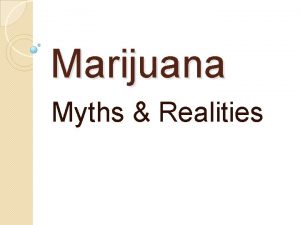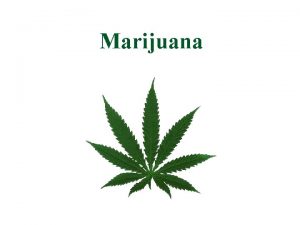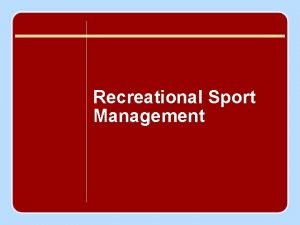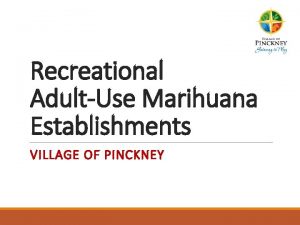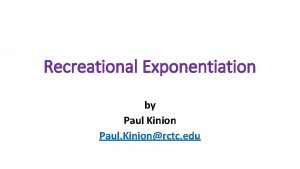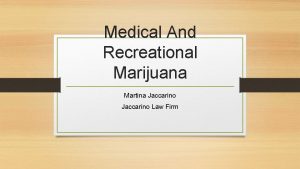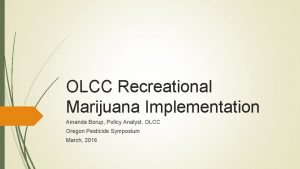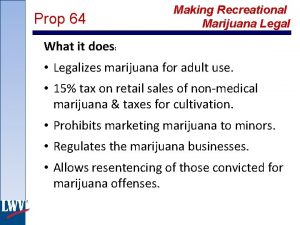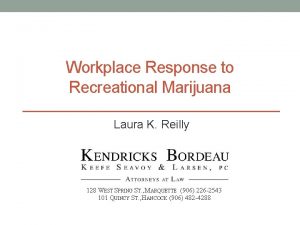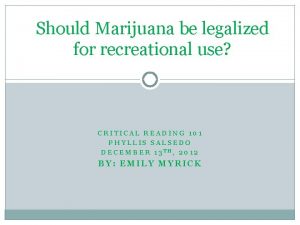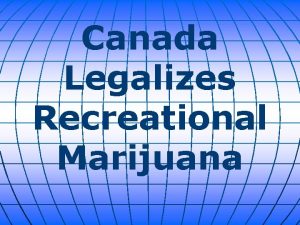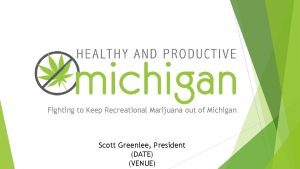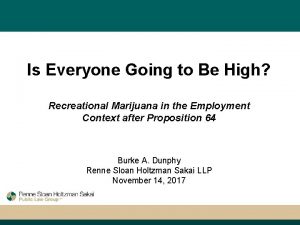Recreational Marijuana 101 Paul Davis Marijuana Education and

























- Slides: 25

Recreational Marijuana 101 Paul Davis, Marijuana Education and Tobacco Prevention Washington State Department of Health 1

Overview • The Law • DOH Mandates • Today’s Marijuana • Medical Vs. Recreational • Marijuana and Health • Education plans 2

The Law I-502 Marijuana Legalization in Washington State • Persons 21 and over can legally purchase, possess and use: Ø One ounce of useable Marijuana Ø 16 oz. of marijuana infused product in solid form; or Ø 72 oz. of marijuana infused product in liquid form. • It is illegal to drive under the influence of Marijuana Ø THC levels greater than 5 nanograms per milliliter of blood. Ø Blood test must be done to determine THC blood levels (no breath) • It is illegal to consume marijuana in the view of the general public. 3

The Department of Health has 3 mandates for implementing Initiative 502 § Marijuana use public health hotline – utilizing evidence based public health approaches – does not advocate an abstinence only approach § Media based education campaign – Separately targeting youth and adults § Community grants program to prevent/reduce marijuana use by youth.

Department of Health Mission • The Department of Health works to protect and improve the health of people in Washington State. • We will continue to seek connections between marijuana use and health and address the risks as evidence emerges. 5

Today’s Marijuana Methods of Marijuana Consumption • Smoking- most traditional form of ingesting marijuana. • Vaporizing- inhaling active ingredients in marijuana through a vapor instead of smoke. • Edibles- marijuana is infused into foods and/or drinks and are eaten. • Topicals- lotions, salves, balms, and sprays that are applied directly to the skin. • Tinctures- a concentrated form of marijuana in an alcohol solution that can be dropped under tongue. 6

Today’s Marijuana Smokeable Marijuana 7

Vaping Today’s Marijuana 8

Edibles Today’s Marijuana 9

Today’s Marijuana Topicals & Tinctures 10

Advertising Today’s Marijuana 11

Today’s Marijuana Medical vs. Recreational 12

Marijuana and Health What we know at this time… • Marijuana is addictive. • There are health consequences associated with marijuana smoke. • There are health risks to infants of mothers who use medical or recreational marijuana. • Driving while under the influence of marijuana is not safe. • Youth marijuana use is associated with higher addiction rates, lowered IQ, and academic failure. • Anxiety, Depression, and existing Mental Health conditions. • Additional concerns: Edibles, E-devices, No regulation of Medical Market. 13

What “Parents” Should Know • Marijuana is Addictive: Most Teens that enter into Treatment Programs in WA State report that Marijuana is the main or only drug they use. • Talk to Your Kids About Marijuana: Teens who use marijuana often start by age 14. Parents should have ongoing conversations by 4 th or 5 th grade. • Express a No Use Attitude: Studies have shown that parents are the #1 influence in their children's lives. • Monitor your Children: Ensure that rules are being followed, remain actively involved in your child’s life, and know who their friends (and friends parents) are. • Monitor your Own Behaviors: You are a role model to your child. Avoid heavy drinking around your child. Do not use marijuana around your child. 14

Marijuana Use by Grade and Year, WA HYS, 2002 -2014 30 25 27 20 19 27 23 22 19 20 18 19 18 17 18 15 10 9 10 2 1 9 8 7 5 2 9 7 2 1 1 1 Grade 6 Grade 8 Grade 10 14 20 12 20 10 20 20 08 06 20 04 20 02 0 20 Percent 25 26 Grade 12 15

Marijuana Use by Race/Ethnicity Among 10 th Grade Youth, WA HYS, 2014 Differences by race and ethnicity Hispanic 23 Multiracial* 20 NH/OPI* 21 Asian* 9 AIAN* 29 Black* 25 White* 17 0 * Non-Hispanic 10 20 30 40 Percent Estimates based all participating 16

Youth E-Cigarette Use by Race/Ethnicity Among 10 th Grade Youth, WA HYS, 2014 Hispanic 22 Multiracial* 20 NH/OPI* 21 Asian* 9 AIAN* 29 Black* 21 White* 18 0 * Non-Hispanic 5 10 15 20 25 30 35 Percent Estimates based on full census of schools 17

Some 2012 data 18

Many youth use more than one substance 19

Marijuana Smoking Among Adults by Income as Percent of Federal Poverty Level in Washington, 2011 -2013 by Race & Hispanic Origin in Washington, 2011 -2013 16 Hispanic 5 Pacific Islander* 8 Asian* 4 American Indian/Alaska Native* 6 14 Age-Adjusted Percent 12 10 8 6 4 2 0 * Non- Hispanic 13 9 8 6 11 White* 10 ** Insufficient data <$25, 000 -$49, 999 $50, 000 -$74, 999 $75, 000 or more Household Income Black* Source: Washington Behavioral Risk Factor Survey 0 5 10 15 Age-Adjusted Percent ource: Washington Behavioral Risk Factor 20

Next steps: • What are some ways we can reduce substance abuse? • Media campaign • Local coalitions • Policies and community norms 21

What’s next with media campaign? • Depends on funding • Youth focused campaign will be informed by focus groups and other research • Continue campaign to encourage parents and adults to talk to kids about not using • www. starttalkingnow. org 22

Focus Group Findings • Still gaps in knowledge about the law • Scare tactics and ‘most of us’ messages tested poorly • Younger kids think marijuana is more dangerous than older ones • Parents and other adults are a good source of information, as are schools • Sharing trustworthy health impacts can be useful • Many kids don’t want their life experience ‘dulled’ 23

24

Questions or Comments? Paul. Davis@doh. wa. gov (360) 236 -3642 25
 Marijuana pros and cons chart
Marijuana pros and cons chart Recreational activities across cultures and genders
Recreational activities across cultures and genders Safety at sports and recreational events act
Safety at sports and recreational events act Ohio medical marijuana tier chart
Ohio medical marijuana tier chart Became marijuana state
Became marijuana state Should marijuana be a medical option
Should marijuana be a medical option Lungs marijuana
Lungs marijuana Marijuana names
Marijuana names Medical marijuana ethics
Medical marijuana ethics Define recreational activities
Define recreational activities Duality in linguistics
Duality in linguistics Recreational activities objectives
Recreational activities objectives Mt rainier recreational forecast
Mt rainier recreational forecast Spectator type of recreational activities
Spectator type of recreational activities Recreation therapy assessment tools
Recreation therapy assessment tools Metaxalone 1600 mg
Metaxalone 1600 mg How to use recreational dive planner
How to use recreational dive planner Duplo examples in philippine literature
Duplo examples in philippine literature Motivation for recreational participation
Motivation for recreational participation What exception if any permits a private pilot
What exception if any permits a private pilot Pwsi recreational soccer
Pwsi recreational soccer Doxepin recreational
Doxepin recreational Compare and contrast lincoln and davis inaugural address
Compare and contrast lincoln and davis inaugural address Special education 101
Special education 101 John-paul marks dwp
John-paul marks dwp Venn diagram formal education and nonformal education
Venn diagram formal education and nonformal education



